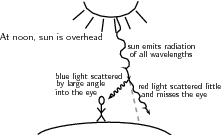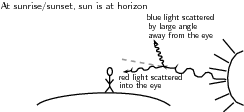| << Chapter < Page | Chapter >> Page > |
Because a truly black object absorbs all the visual wavelengths of light, and does not re-emit photons at visual wavelengths, we can say that 'black' is not a colour itself, but rather a lack of colour! Also, since black objects absorb visual light, they heat up more than objects of other colours which reflect light at certain wavelengths.
Aim:
Investigate the interaction of light with differently coloured metal objects
Apparatus:
Find some differently coloured metal objects (at least 5) which will not be damaged if left in the sun for 15 minutes. Make sure to include at least one white item and one black item.
Method:
At the start of your lesson set out your objects in direct sunlight. Leave them there for around 15 minutes.
Alternatively, if it is a sunny day, you can use your teachers' cars for this experiment - as long as there are some cars of different colours and they have been standing in direct sunlight for the same length of time!
After 15 minutes is up, touch each of the items/cars (be careful not to burn yourself!) and compare their temperatures (rate them from 1 to 5 with 1 being cold and 5 being very hot) in a table such as the example table below:
| Object | Colour | Temperature rating |
| e.g. car 1 | e.g. red | e.g. 3 |
Questions:
Metals generally reflect most wavelengths of visible light, but they will reflect the light in a certain direction, given by the laws of reflection in geometrical optics. This is different to most materials, like wood or fabric, which reflect light in all directions. Metals have this property since they have electrons that are not bound to atoms and can move freely through the metal. This is unlike most other materials that have their electrons bound closely to the atoms. These free electrons in metals can then absorb and reflect photons of a wide range of energies.
Ultraviolet light (which has shorter wavelengths than visible light) will pass through some substances, such as many plastics, because they do not have the right energy levels to absorb it and re-emit it. X-rays (also short wavelengths) will also pass through most materials, since the energies of X-rays correspond to the energy levels of atomic nuclei. Such nuclei are much smaller than atoms, so it is much less likely for an X-ray to hit a nucleus instead of the whole atom.
Most materials will absorb infrared radiation (longer wavelengths than visible light), since the energies of that radiation often correspond to rotational or vibrational energy levels of molecules.

The sun emits light at many different wavelengths, including all of the visible wavelengths. Light which is made up of all the visible wavelengths appears white. So what causes the sky to look blue?
The atmosphere consists of molecules of different gases as well as tiny dust grains. Light from the sun scatters off the molecules in the air (called Rayleigh scattering ). The chance that the light will scatter off the gas molecules is higher for shorter wavelengths. The short wavelength blue light is therefore scattered more than the other colours. At noon, when the light from the sun is coming straight down (see the picture), the scattered blue light reaches your eyes from all directions and so the sky appears blue. The other wavelengths do not get scattered much and therefore miss your line of sight and are not seen. At sunrise or sunset, the direction of the light coming from the sun is now straight towards your eyes (see the picture). Therefore the scattered blue light can't be seen because it is scattered out of your line of sight. The redder colours (oranges and reds) can now be seen because they are not scattered as much and still fall in your line of sight.



Notification Switch
Would you like to follow the 'Siyavula textbooks: grade 12 physical science' conversation and receive update notifications?